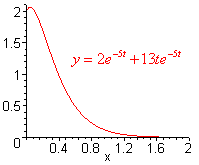Repeated Roots and Reduction of Order
Now that we know how to solve second order linear homogeneous differential equations with constant coefficients such that the characteristic equation has distinct roots (either real or complex), the next task will be to deal with those which have repeated roots. We proceed with an example.
Example
Solve
y'' - 12y' + 36y = 0
Solution
The characteristic equation is
r2 - 12r + 36 = 0
or
(r - 6)2 = 0
We have only the root r = 6 which gives the solution
y1 = e6t
By general theory, there must be two linearly independent solutions to the differential equation. We have found one and now search for a second. Fortunately, a long time ago a mathematician named D'Alembert came up with a way to find the second linearly independent solution. His idea was to write the second solution in the form
y2 = v(t)e6t
and solve for v(t). The derivatives are
y2' = v'(t)e6t + 6v(t)e6t = (v'(t) + 6v(t))e6t
y2'' = (v''(t) + 6v'(t))e6t + 6(v'(t) + 6v(t))e6t = (v''(t) + 12v'(t) + 36v(t))e6t
Since y2 is a solution to the differential equation, we can plug it in to get
(v''(t) + 12v'(t) + 36v(t))e6t - 12[(v'(t) + 6v(t))e6t] + 36v(t)e6t
= [v''(t) + 12v'(t) + 36v(t) - 12v'(t) - 72v(t) + 36v(t)]e6t
= v''(t)e6t = 0
Since an exponential is never zero, we can conclude that
v''(t) = 0
Integrating twice gives
v(t) = c2t + c3
For c2 = 0 and c3 = 1, we get the original solution from the characteristic equation. However, for c2 = 1 and c3 = 0, we get
y2 = v(t)e6t = te6t
We need to check that y1 and y2 are linearly independent. We compute the Wronskian
W = (e6t)(e6t + 6te6t) - (6e6t)(te6t) = e12t + 6te12t 6te12t = e12t
Since the Wronskian is an exponential, it is nonzero. Hence the two solutions are linearly independent. The general solution is
y = c1e6t + c2te6t
| Theorem (Solution for Repeated
Roots)
Let ay'' + by' + cy = 0 be a differential equation such that the characteristic equation has the repeated root r. That is b2 - 4ac = 0 Then the general solution to the differential equation is given by y = c1ert + c2tert |
To prove this theorem, we just go through the same steps as in the example above. We will leave out the general proof here. The proof can be found at http://www.math.colostate.edu/m340/notes/ODEI/node4.html among other places.
Example
Find the solution to
y'' + 10y' + 25y = 0 y(0) = 2, y'(0) = 3
Solution
The characteristic equation is
r2 + 10r + 25 = (r + 5)2 = 0
This has the repeated root of r = -5. The general solution is
y = c1e-5t + c2te-5t
We use the initial values to determine the constants
2 = c1e-5(0) + c2(0)e-5(0) = c1
Taking the derivative gives
y' = -10e-5t + c2(e-5t - 5te-5t)
Plugging in the initial value gives
3 = -10 + c2(1 - 0)
c2 = 13
The final solution is
y = 2e-5t + 13te-5t
The graph is pictured below

When there are repeated roots, one of the linearly independent solutions was easy to find, while for the other solution we assumed that it had the form of a function times the known solution. This approach works more generally.
If y1 is a known solution to a homogeneous linear differential equation, then we can seek a second linearly independent solution by writing
y2 = v(t)y1
We demonstrate this with an example.
Example
Given that y1 = t is a solution to the differential equation
t2y'' + 2ty' - 2y = 0
Find the general solution.
Solution
We write
y2 = vt y2' = v't + v y2'' = v''t + v' + v' = v''t + 2v'
Substituting back into the differential equation gives
t2(v''t + 2v') + 2t(v't + v) - 2(vt) = 0
t3v'' + 2t2v' + 2t2v' + 2tv - 2tv = 0
t3v'' + 4t2v' = 0
tv'' + 4v' = 0
Notice that the "v" term dropped out. This will always be the case. We can now let
u = v' u' = v''
Substituting gives
tu' + 4u = 0
This is a first order differential equation (hence the title "Reduction of Order"). We can separate to get
du/u = -4dt/t
Now integrate to get
ln|u| = -4ln|t| + C
u = Ct -4
v' = Ct -4
v = Ct -5
We can conclude that a second linearly independent solution is given by
y2 = (t-3)(t) = t -2
The general solution is
y = c1t + c2t -2
Back to the Linear Second Order Differential Equations Home Page
Back to the Differential Equations Home Page
Back to the Math Department Home Page
e-mail Questions and Suggestions